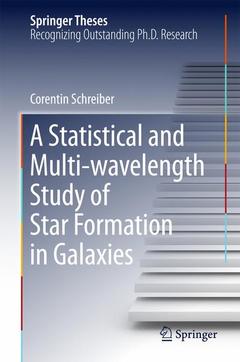Description
A Statistical and Multi-wavelength Study of Star Formation in Galaxies, Softcover reprint of the original 1st ed. 2016
Springer Theses Series
Language: English
Subject for A Statistical and Multi-wavelength Study of Star...:
A Statistical and Multi-wavelength Study of Star Formation in Galaxies
Publication date: 09-2016
Support: Print on demand
Publication date: 09-2016
Support: Print on demand
A Statistical and Multi-wavelength Study of Star Formation in Galaxies
Publication date: 06-2018
Support: Print on demand
Publication date: 06-2018
Support: Print on demand
Description
/li>Contents
/li>Biography
/li>Comment
/li>
This thesis presents a pioneering method for gleaning the maximum information from the deepest images of the far-infrared universe obtained with the Herschel satellite, reaching galaxies fainter by an order of magnitude than in previous studies. Using these high-quality measurements, the author first demonstrates that the vast majority of galaxy star formation did not take place in merger-driven starbursts over 90% of the history of the universe, which suggests that galaxy growth is instead dominated by a steady infall of matter. The author further demonstrates that massive galaxies suffer a gradual decline in their star formation activity, providing an alternative path for galaxies to stop star formation. One of the key unsolved questions in astrophysics is how galaxies acquired their mass in the course of cosmic time. In the standard theory, the merging of galaxies plays a major role in forming new stars. Then, old galaxies abruptly stop forming stars through an unknown process. Investigating this theory requires an unbiased measure of the star formation intensity of galaxies, which has been unavailable due to the dust obscuration of stellar light.
Introduction.- Summary of the Work Done in This Thesis.- Modelling the Integrated IR Photometry of Star-forming Galaxies.- Gencat: An Empirical Simulation of the Observable Universe.- The Downfall of Massive Star-Forming Galaxies During the Last 10 Gyr.- Reaching the Distant Universe with ALMA.- Conclusions and Perspectives.
Corentin Schreiber is currently a post-doctoral researcher at Leiden University, in the Netherlands, studying massive galaxies in the distant Universe. He did his PhD in CEA Saclay, France, under the joint supervision of David Elbaz and Maurilio Pannella.
Nominated as an outstanding PhD thesis by the Service d'Astrophysique, CEA Saclay, France Analyses Herschel satellite data with a novel method, revealing information about galaxies an order of magnitude fainter than any so far studied Presents new evidence suggesting that galaxy growth is dominated by a steady infall of matter Includes supplementary material: sn.pub/extras
© 2024 LAVOISIER S.A.S.




